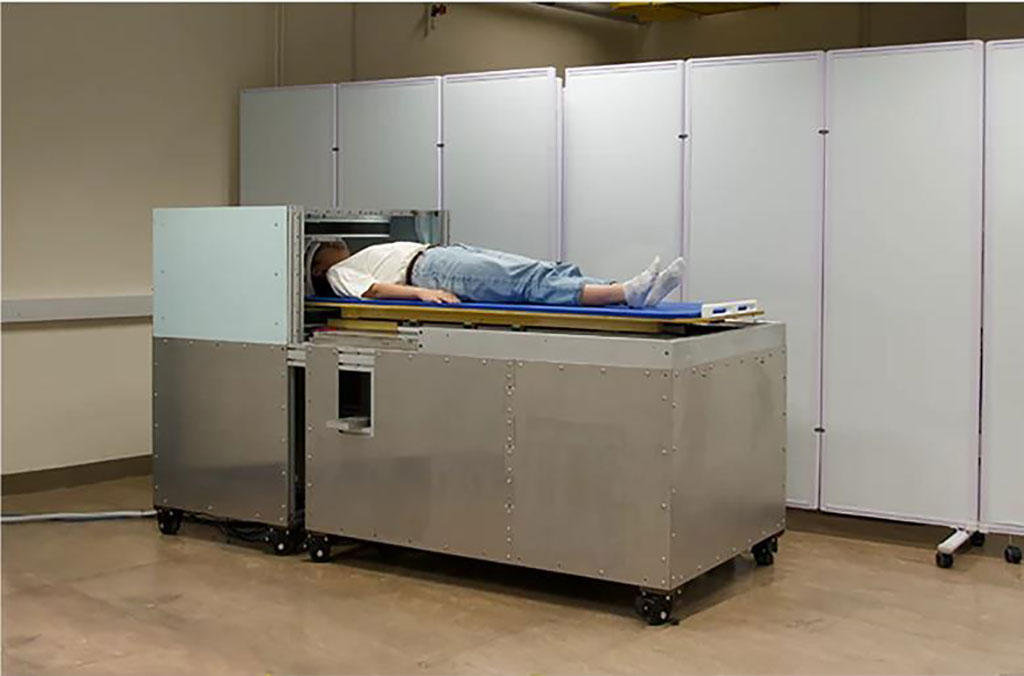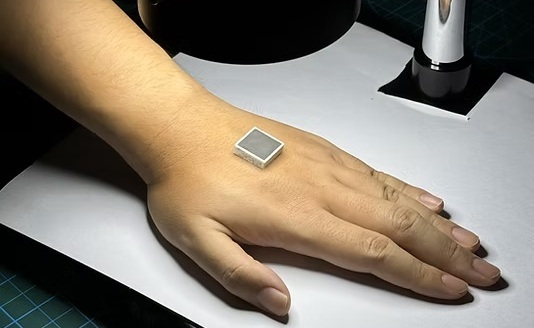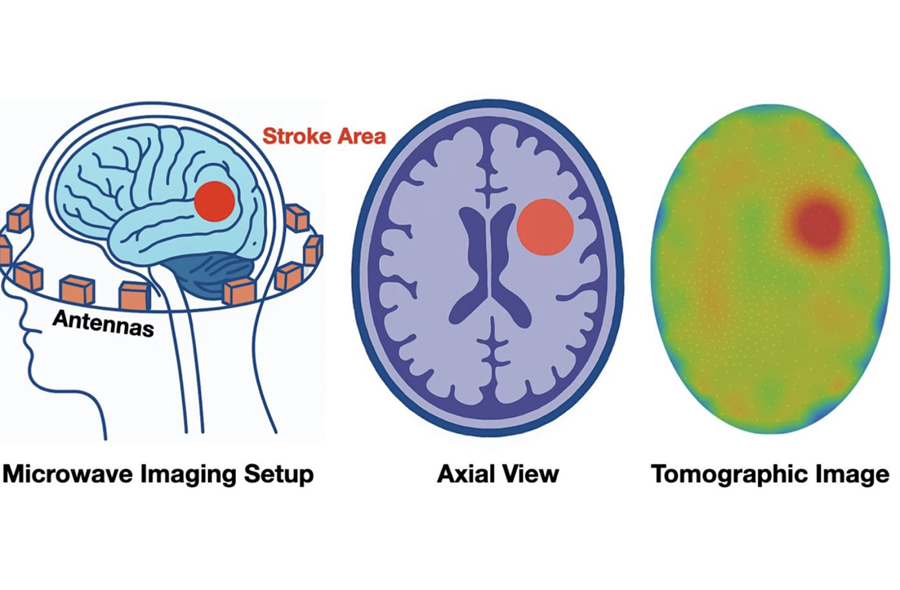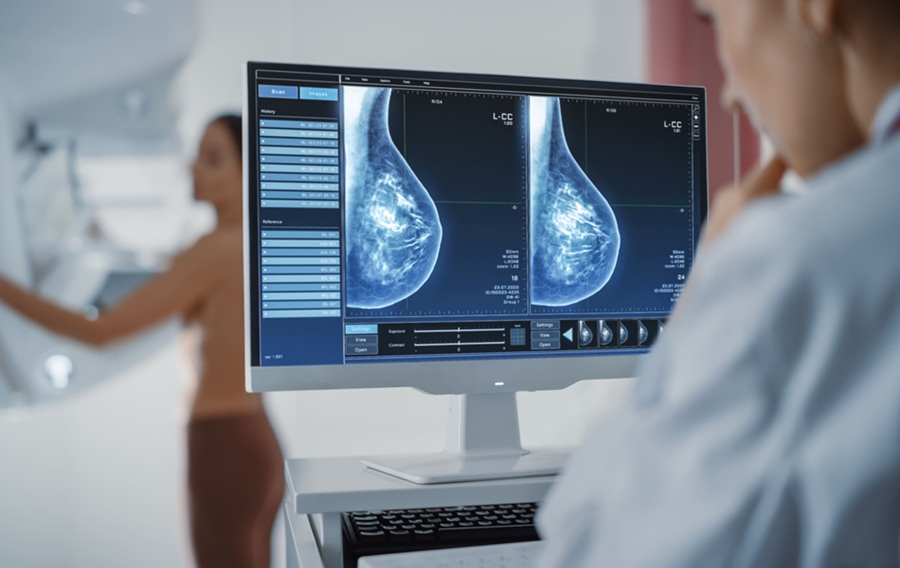New MRI Scanner Meets Third World Needs
|
By MedImaging International staff writers Posted on 27 Dec 2021 |

Image: The prototype ULF MRI brain scanner (Photo courtesy of HKU)
An ultra-low magnetic field (ULF) MRI scanner has the potential to meet clinical point of care (POC) needs in low and middle income countries.
Developed at the University of Hong Kong (HKU; China), the ULF MRI scanner uses a permanent 0.055 Tesla Samarium-cobalt magnet and deep learning (DL) algorithms for cancellation of electromagnetic interference, and as a result requires neither magnetic nor radiofrequency (RF) shielding cages. The compact, mobile scanner is intended for brain scanning, powered via a standard AC power outlet, is also and acoustically quiet during scanning. According to the HKU developers, it can be constructed for less than USD 20,000.
To test its capabilities, they implemented four standard clinical neuroimaging protocols (T1- and T2-weighted, fluid-attenuated inversion recovery like, and diffusion-weighted imaging) on 25 patients, successfully demonstrating preliminary feasibility in the diagnosis of brain tumors and stroke. In addition, as the system is ULF, it also has lower sensitivity to metallic implants, less susceptibility to artifacts at the air/tissue interface, and an extremely low RF specific absorption rate (SAR). The study describing the new MRI system was published on December 14, 2021, in Nature Communications.
“The high cost of procuring, siting/installing, maintaining and operating the current clinical scanners constitutes a major roadblock in MRI accessibility in healthcare,” concluded senior author professor of biomedical engineering Ed X. Wu, PhD, and colleagues. “Low-cost, low-power, compact, open, and shielding-free [ultra-low magnetic field] MRI for brain imaging, as demonstrated here, aims to complement rather than compete with existing high performance clinical MRI in healthcare.”
According to the Organization for Economic Co-operation and Development (OECD), in 2020 there were approximately 65,000 installations of MRI scanners worldwide (or approximately seven per one million inhabitants), as compared to about 200,000 CT scanners and over 1,500,000 ultrasound scanners. The distribution of MRI scanners is concentrated mainly within high income countries, with scarce availability in low and middle income countries. As a result, 70% of the world’s population has little to no access to MRI.
Related Links:
University of Hong Kong
Developed at the University of Hong Kong (HKU; China), the ULF MRI scanner uses a permanent 0.055 Tesla Samarium-cobalt magnet and deep learning (DL) algorithms for cancellation of electromagnetic interference, and as a result requires neither magnetic nor radiofrequency (RF) shielding cages. The compact, mobile scanner is intended for brain scanning, powered via a standard AC power outlet, is also and acoustically quiet during scanning. According to the HKU developers, it can be constructed for less than USD 20,000.
To test its capabilities, they implemented four standard clinical neuroimaging protocols (T1- and T2-weighted, fluid-attenuated inversion recovery like, and diffusion-weighted imaging) on 25 patients, successfully demonstrating preliminary feasibility in the diagnosis of brain tumors and stroke. In addition, as the system is ULF, it also has lower sensitivity to metallic implants, less susceptibility to artifacts at the air/tissue interface, and an extremely low RF specific absorption rate (SAR). The study describing the new MRI system was published on December 14, 2021, in Nature Communications.
“The high cost of procuring, siting/installing, maintaining and operating the current clinical scanners constitutes a major roadblock in MRI accessibility in healthcare,” concluded senior author professor of biomedical engineering Ed X. Wu, PhD, and colleagues. “Low-cost, low-power, compact, open, and shielding-free [ultra-low magnetic field] MRI for brain imaging, as demonstrated here, aims to complement rather than compete with existing high performance clinical MRI in healthcare.”
According to the Organization for Economic Co-operation and Development (OECD), in 2020 there were approximately 65,000 installations of MRI scanners worldwide (or approximately seven per one million inhabitants), as compared to about 200,000 CT scanners and over 1,500,000 ultrasound scanners. The distribution of MRI scanners is concentrated mainly within high income countries, with scarce availability in low and middle income countries. As a result, 70% of the world’s population has little to no access to MRI.
Related Links:
University of Hong Kong
Latest MRI News
- Novel Imaging Approach to Improve Treatment for Spinal Cord Injuries
- AI-Assisted Model Enhances MRI Heart Scans
- AI Model Outperforms Doctors at Identifying Patients Most At-Risk of Cardiac Arrest
- New MRI Technique Reveals Hidden Heart Issues
- Shorter MRI Exam Effectively Detects Cancer in Dense Breasts
- MRI to Replace Painful Spinal Tap for Faster MS Diagnosis
- MRI Scans Can Identify Cardiovascular Disease Ten Years in Advance
- Simple Brain Scan Diagnoses Parkinson's Disease Years Before It Becomes Untreatable
- Cutting-Edge MRI Technology to Revolutionize Diagnosis of Common Heart Problem
- New MRI Technique Reveals True Heart Age to Prevent Attacks and Strokes
- AI Tool Predicts Relapse of Pediatric Brain Cancer from Brain MRI Scans
- AI Tool Tracks Effectiveness of Multiple Sclerosis Treatments Using Brain MRI Scans
- Ultra-Powerful MRI Scans Enable Life-Changing Surgery in Treatment-Resistant Epileptic Patients
- AI-Powered MRI Technology Improves Parkinson’s Diagnoses
- Biparametric MRI Combined with AI Enhances Detection of Clinically Significant Prostate Cancer
- First-Of-Its-Kind AI-Driven Brain Imaging Platform to Better Guide Stroke Treatment Options
Channels
Radiography
view channel
AI Detects Early Signs of Aging from Chest X-Rays
Chronological age does not always reflect how fast the body is truly aging, and current biological age tests often rely on DNA-based markers that may miss early organ-level decline. Detecting subtle, age-related... Read more
X-Ray Breakthrough Captures Three Image-Contrast Types in Single Shot
Detecting early-stage cancer or subtle changes deep inside tissues has long challenged conventional X-ray systems, which rely only on how structures absorb radiation. This limitation keeps many microstructural... Read moreUltrasound
view channel
Wearable Ultrasound Imaging System to Enable Real-Time Disease Monitoring
Chronic conditions such as hypertension and heart failure require close monitoring, yet today’s ultrasound imaging is largely confined to hospitals and short, episodic scans. This reactive model limits... Read more
Ultrasound Technique Visualizes Deep Blood Vessels in 3D Without Contrast Agents
Producing clear 3D images of deep blood vessels has long been difficult without relying on contrast agents, CT scans, or MRI. Standard ultrasound typically provides only 2D cross-sections, limiting clinicians’... Read moreNuclear Medicine
view channel
PET Imaging of Inflammation Predicts Recovery and Guides Therapy After Heart Attack
Acute myocardial infarction can trigger lasting heart damage, yet clinicians still lack reliable tools to identify which patients will regain function and which may develop heart failure.... Read more
Radiotheranostic Approach Detects, Kills and Reprograms Aggressive Cancers
Aggressive cancers such as osteosarcoma and glioblastoma often resist standard therapies, thrive in hostile tumor environments, and recur despite surgery, radiation, or chemotherapy. These tumors also... Read more
New Imaging Solution Improves Survival for Patients with Recurring Prostate Cancer
Detecting recurrent prostate cancer remains one of the most difficult challenges in oncology, as standard imaging methods such as bone scans and CT scans often fail to accurately locate small or early-stage tumors.... Read moreGeneral/Advanced Imaging
view channel
AI-Based Tool Accelerates Detection of Kidney Cancer
Diagnosing kidney cancer depends on computed tomography scans, often using contrast agents to reveal abnormalities in kidney structure. Tumors are not always searched for deliberately, as many scans are... Read more
New Algorithm Dramatically Speeds Up Stroke Detection Scans
When patients arrive at emergency rooms with stroke symptoms, clinicians must rapidly determine whether the cause is a blood clot or a brain bleed, as treatment decisions depend on this distinction.... Read moreImaging IT
view channel
New Google Cloud Medical Imaging Suite Makes Imaging Healthcare Data More Accessible
Medical imaging is a critical tool used to diagnose patients, and there are billions of medical images scanned globally each year. Imaging data accounts for about 90% of all healthcare data1 and, until... Read more
Global AI in Medical Diagnostics Market to Be Driven by Demand for Image Recognition in Radiology
The global artificial intelligence (AI) in medical diagnostics market is expanding with early disease detection being one of its key applications and image recognition becoming a compelling consumer proposition... Read moreIndustry News
view channel
GE HealthCare and NVIDIA Collaboration to Reimagine Diagnostic Imaging
GE HealthCare (Chicago, IL, USA) has entered into a collaboration with NVIDIA (Santa Clara, CA, USA), expanding the existing relationship between the two companies to focus on pioneering innovation in... Read more
Patient-Specific 3D-Printed Phantoms Transform CT Imaging
New research has highlighted how anatomically precise, patient-specific 3D-printed phantoms are proving to be scalable, cost-effective, and efficient tools in the development of new CT scan algorithms... Read more
Siemens and Sectra Collaborate on Enhancing Radiology Workflows
Siemens Healthineers (Forchheim, Germany) and Sectra (Linköping, Sweden) have entered into a collaboration aimed at enhancing radiologists' diagnostic capabilities and, in turn, improving patient care... Read more




















